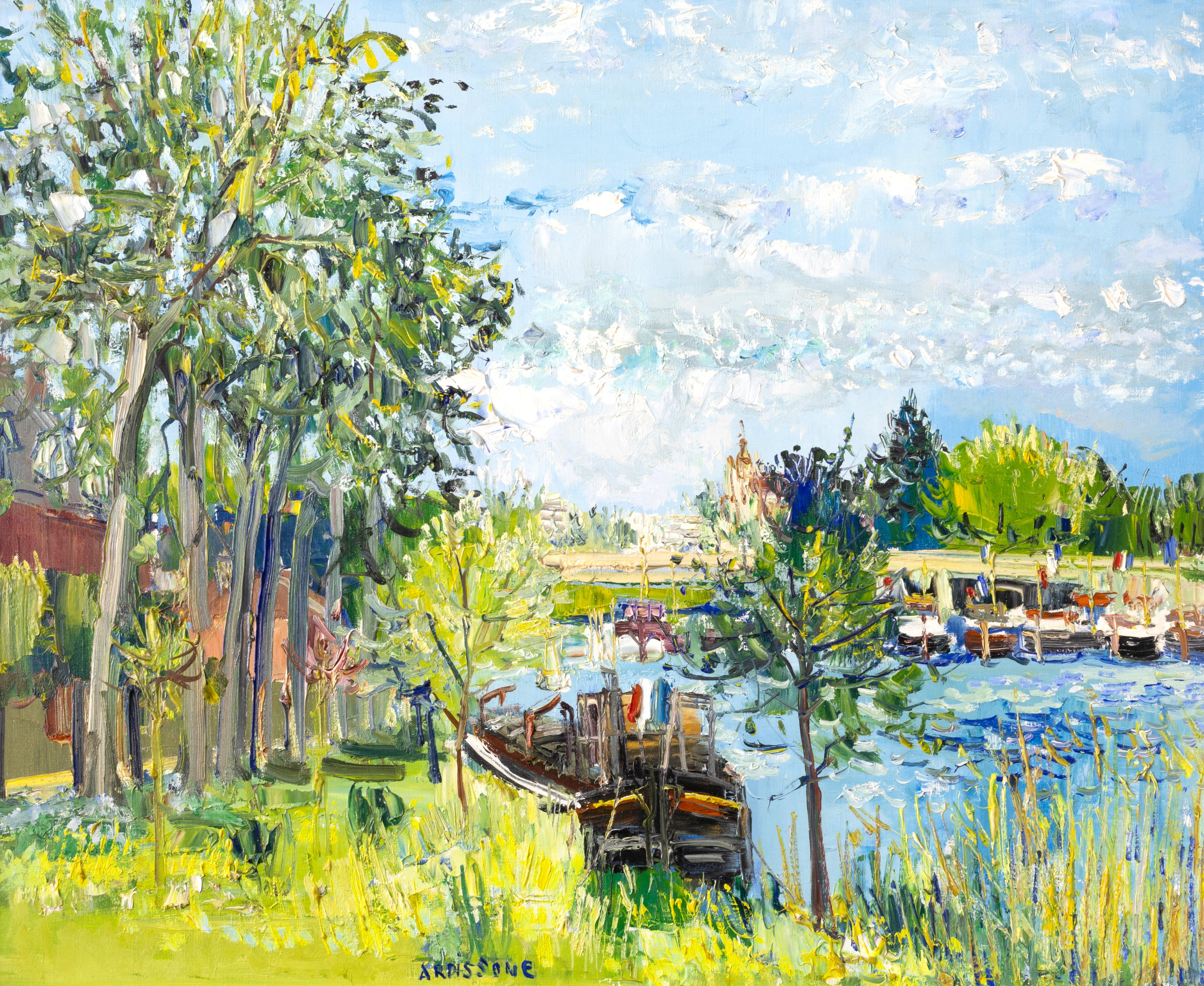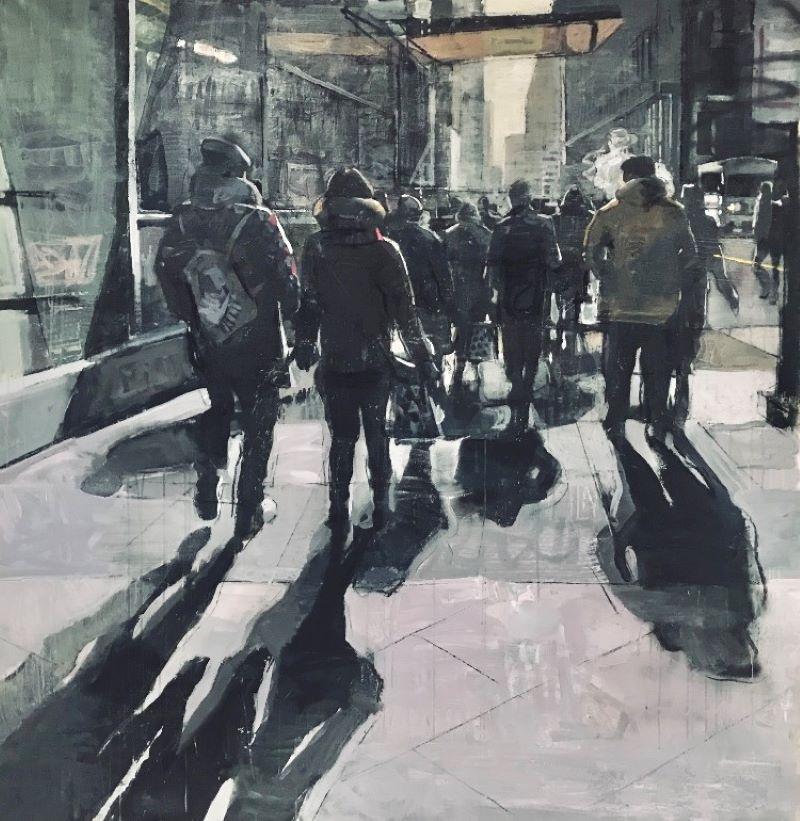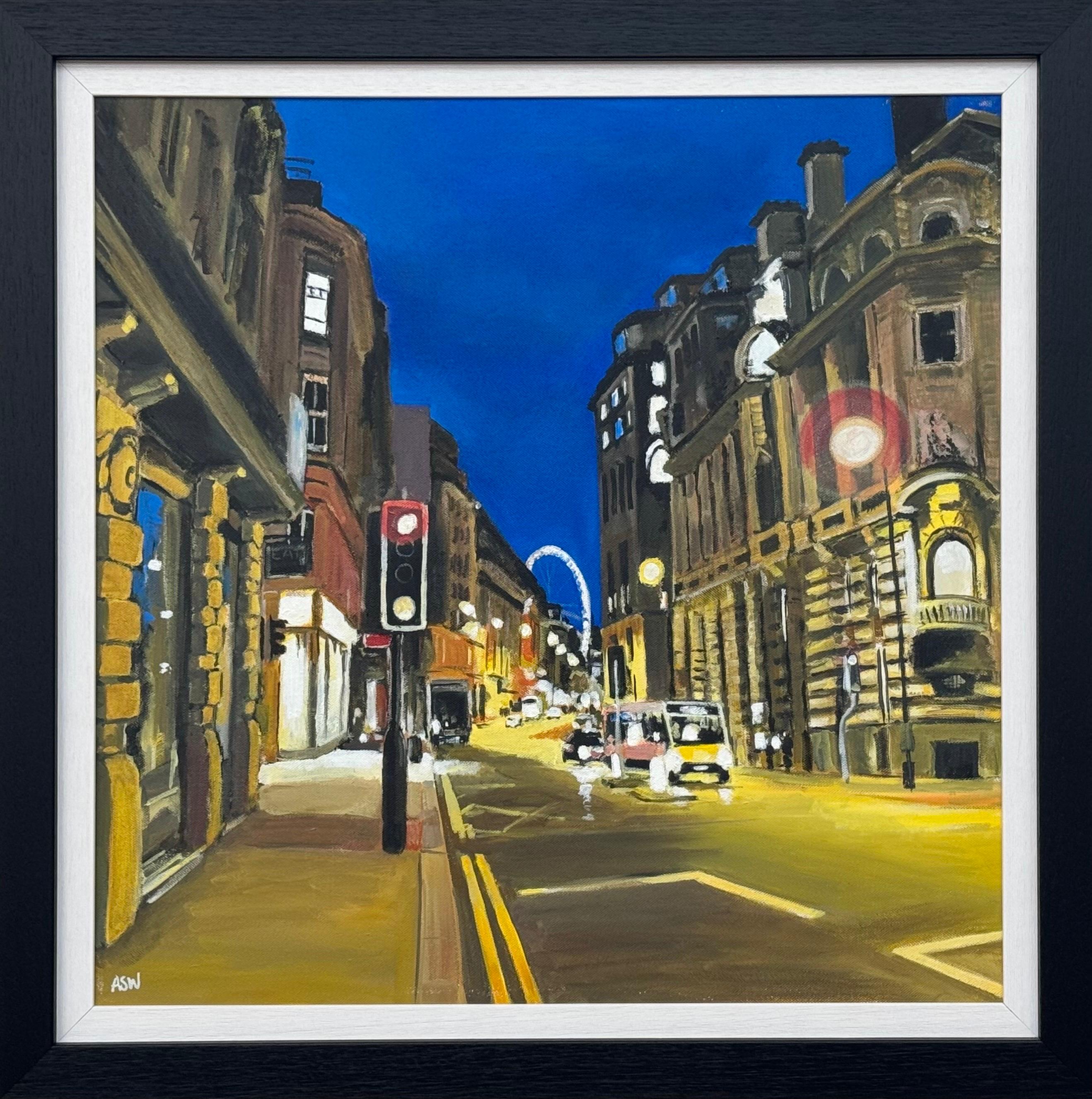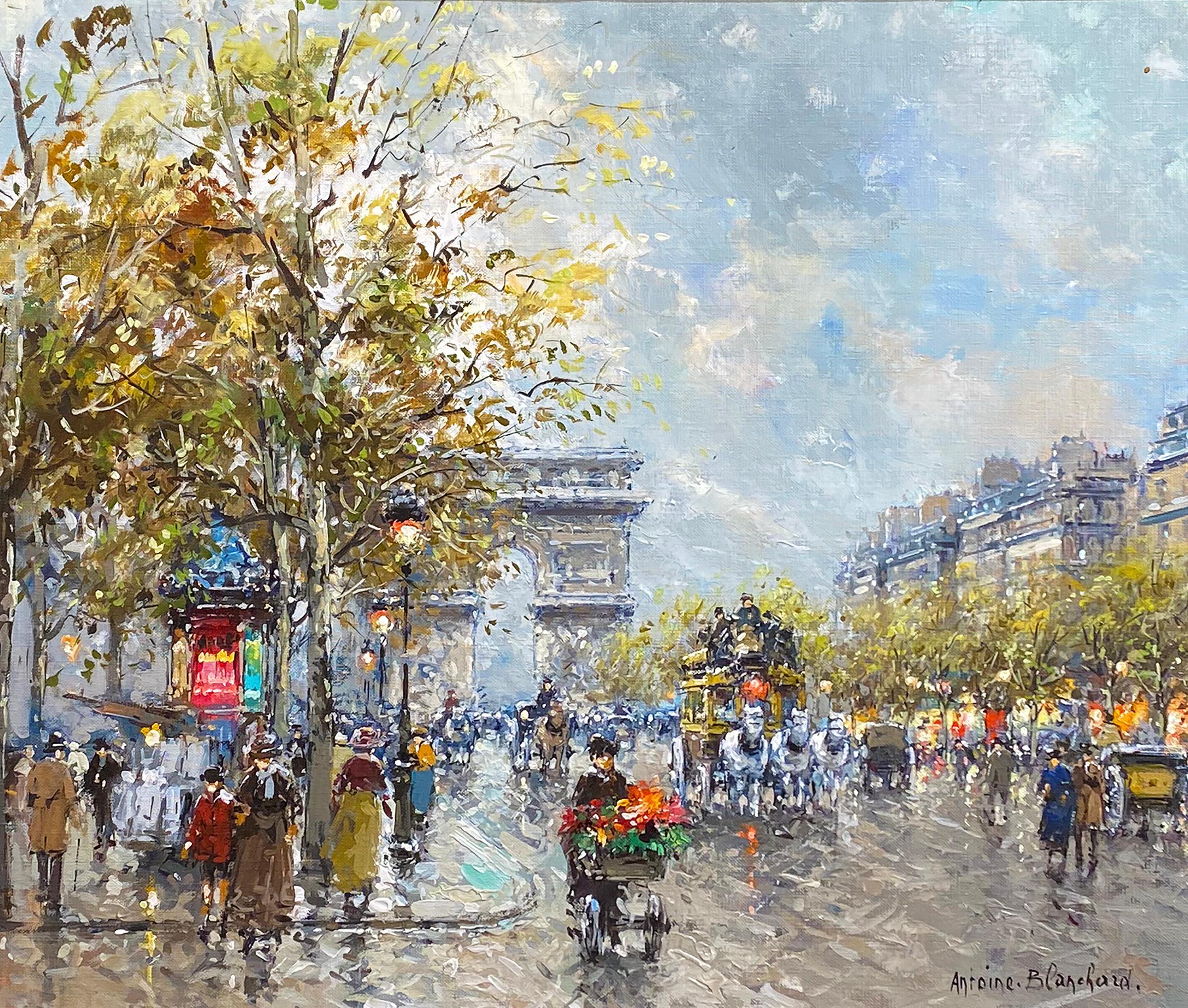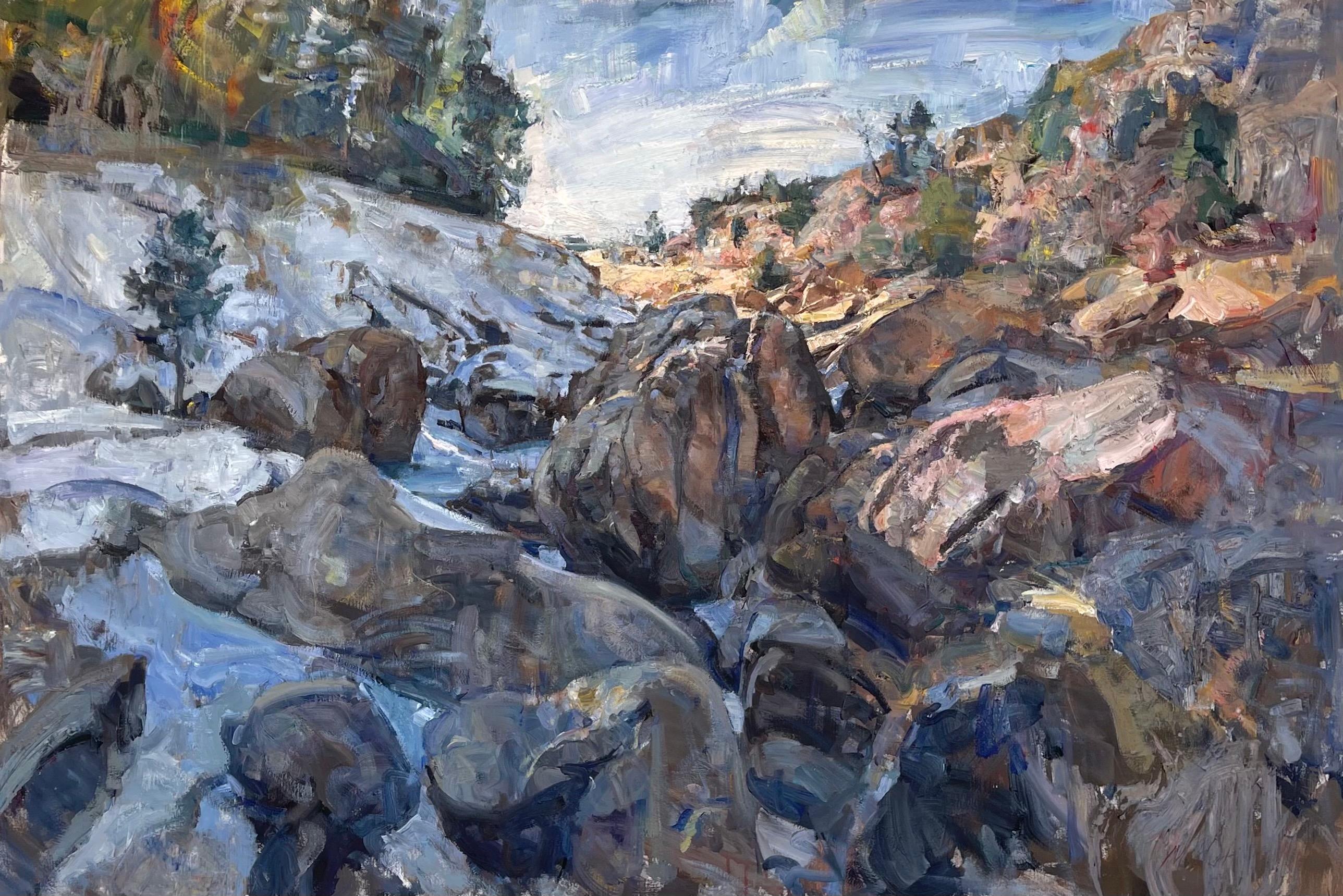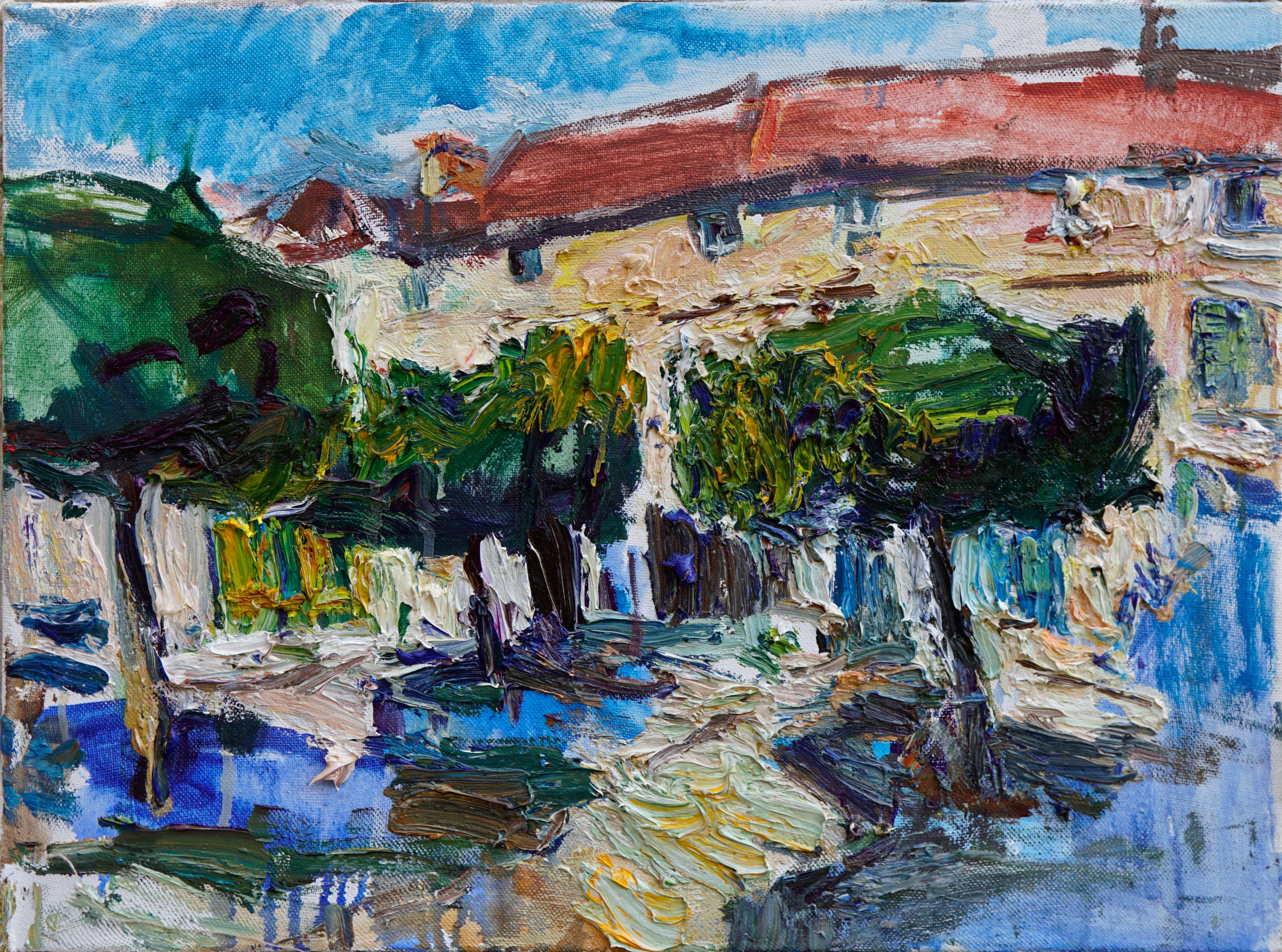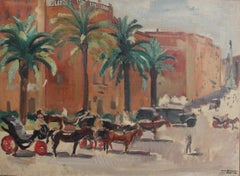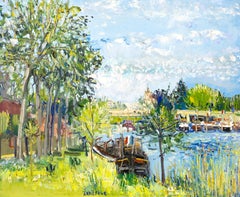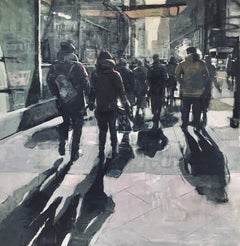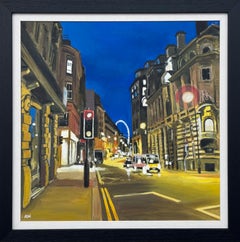Items Similar to Mountain Landscape
Want more images or videos?
Request additional images or videos from the seller
1 of 22
Louise Jeanne Cottard-FosseyMountain Landscapecirca 1950s
circa 1950s
About the Item
'Mountain Landscape', oil on canvas, by Louise-Jeanne Cottard-Fossey (circa 1950s). A very idyllic, verdant scene depicted by this renown French female artist whose works were created in an era when art was dominated by males. A cabin sits under a rocky crag in a remote region in one of France's mountainous areas. With such a peaceful view, the viewer can slow down, put her feet up and relish the silence and tranquility of the scene. Fresh mountain air and not a human in sight - the painting transports the viewer to a better place and that is a good thing. In good overall condition, the painting is framed and signed by the artist in the lower right hand corner. Upon request a video of the artwork may be provided.
About the Artist: Louise-Jeanne Cottard-Fossey, (1902-1983), born in Le Havre, France, she studied at the University of Beaux Arts in that city and subsequently at the École des Arts Décoratifs in Paris. Cottard-Fossey was also a student of well known French artist, Othon Friesz, himself a lifelong friend of Raoul Dufy and several French Fauvists. She is most known for her nude portraits, landscapes and still-lifes. Cottard-Fossey's paintings currently hang in the Musée d’Art Moderne, Paris and its equivalent in Le Havre.
Dimensions with frame:
H 76 cm / 29.9"
W 84.5 cm / 33.3"
Dimensions without frame:
H 54cm / 21.3"
W 63 cm / 24.8"
- Creator:Louise Jeanne Cottard-Fossey (1902 - 1983, French)
- Creation Year:circa 1950s
- Dimensions:Height: 29.93 in (76 cm)Width: 33.27 in (84.5 cm)
- Medium:
- Period:
- Condition:
- Gallery Location:London, GB
- Reference Number:Seller: 12761stDibs: LU61738504482
Louise Jeanne Cottard-Fossey
Louise Jeanne Cottard-Fossey was a French artist born in 1902. She was known for painting landscapes, watercolor and nudes. She died in 1983.
About the Seller
5.0
Platinum Seller
Premium sellers with a 4.7+ rating and 24-hour response times
Established in 2016
1stDibs seller since 2017
496 sales on 1stDibs
Typical response time: <1 hour
- ShippingRetrieving quote...Shipping from: London, United Kingdom
- Return Policy
Authenticity Guarantee
In the unlikely event there’s an issue with an item’s authenticity, contact us within 1 year for a full refund. DetailsMoney-Back Guarantee
If your item is not as described, is damaged in transit, or does not arrive, contact us within 7 days for a full refund. Details24-Hour Cancellation
You have a 24-hour grace period in which to reconsider your purchase, with no questions asked.Vetted Professional Sellers
Our world-class sellers must adhere to strict standards for service and quality, maintaining the integrity of our listings.Price-Match Guarantee
If you find that a seller listed the same item for a lower price elsewhere, we’ll match it.Trusted Global Delivery
Our best-in-class carrier network provides specialized shipping options worldwide, including custom delivery.More From This Seller
View AllThe Port of Honfleur
Located in London, GB
'The Port of Honfleur', oil on canvas, by Gervais Leterreux (1993). This is a charming painting of the port of Honfleur. Especially known for its old port, Honfleur is characterised ...
Category
1990s Landscape Paintings
Materials
Canvas, Oil
$1,086 Sale Price
38% Off
Cabins in the Camargue
By Yves Brayer
Located in London, GB
'Cabins in the Camargue' by Yves Brayer (circa 1950s). The Camargue is a vast, swampy delta near Arles, very exotic, with tall marsh grasses where pink flamingos, black bulls and white horses roam freely. This image depicts one of the gardians in a small gathering of cabanes, hat hanging cowboy-style around the back of the neck, as he approaches his horse grazing outside its modest stable. Although there are many horses that still run free in the Camargue, there are cowboys like this one — called gardians — who ride the white horses on the beaches...
Category
1950s Landscape Paintings
Materials
Canvas, Oil
$9,505 Sale Price
30% Off
Piazza di Spagna Roma
By Yves Brayer
Located in London, GB
'Piazza di Spagna, Roma' oil on canvas, by Yves Brayer (1933). At the bottom of the Spanish Steps, is one of the most famous squares in Rome. It owes ...
Category
1930s Expressionist Landscape Paintings
Materials
Canvas, Oil
$13,579 Sale Price
20% Off
Boats on a Pond
By Charles Kvapil
Located in London, GB
'Boats on a Pond', oil on canvas, by Charles Kvapil (circa 1930s). This tranquil artwork depicts people fishing from their small boats. The motionless pond is surrounded by lush foliage with some homes as backdrop. The painting is spattered with light. With hardly any air moving in the scene, the still water plays...
Category
1930s Landscape Paintings
Materials
Canvas, Oil
$4,182 Sale Price
30% Off
The Boat in Martigues, France
By Marie-Anne Nivoulies de Pierrefort
Located in London, GB
'The Boat in Martigues', oil on canvas, by Marie de Nivouliès de Pierrefort (circa 1910). Martigues is a small port town just northwest of Marseille in the South of France. Its nickname is the Provençal Venice. Further eastward down the coast is the town of Toulon where the artist was born in 1879. Nivouliès depicts a charming sailboat tied to the small pier yet with an unfurled sail. It looks to be a wondrous day along the Mediterranean, the kind we can always dream about. The painting is over one hundred years old and is in fair condition, yet recently brought back to life by an art restoration professional. Elegantly framed, it is stabilised now for decades into the future. Please enjoy the many photos accompanying the listing. Upon request, a video may be provided of the artwork.
About the Artist: Although she was a direct descendant of the counts of de Pierrefort, Marie de Nivouliès de Pierrefort's (1879-1968) family was very poor. In spite of the poverty, Pierrefort attended a Catholic school run by nuns, obtaining a scholarship from the School of Fine Arts of Paris. While still a student, she attended workshops of great Impressionist masters such as Pierre Auguste Renoir (1841-1919) and Pierre Bonnard (1867-1947). In 1910 she won a travel award from the school and traveled to Tunisia where she painted several Mediterranean landscapes.
In 1938 the painter moved to Rio de Janeiro, Brazil, where she painted the beautiful landscapes seen from her window. In Rio, Pierrefort had two individual exhibitions, both at the National Museum of Fine Arts, in the years 1946 and 1956.
Although widowed in 1944, Pierrefort decided not to return to France until 1950. She remained there until 1959 when she definitively returned to Brazil. Her atelier in the neighbourhood of Glória was frequented by many emerging artists who learned the techniques of impressionism from her. Afterwards, Pierrefort painted for almost a decade in Brazil until she passed away in 1968 in Rio. After her death, many canvases were found in her studio but had been damaged or destroyed by humidity and by the intervention of her many cats. The painter Sergio Telles...
Category
1910s Impressionist Landscape Paintings
Materials
Canvas, Oil
$2,804 Sale Price
30% Off
'Port of Saint-Malo', French Modern School
Located in London, GB
'Port of Saint-Malo', oil on canvas affixed to board, French Modern School (1984). Although the artist dated this painting '84, it depicts a nostalgic view of the port of Saint-Malo in Western France's, Brittany in 1884 judging by the clothing worn by the characters depicted. The crowd on the shoreline is watching a sailboat regatta starting just inside the port's breakwater. A rather rare sunny day in Brittany brought out the parasols of the sitting ladies on the edge of the old ramparts. The walled city...
Category
1980s Modern Landscape Paintings
Materials
Canvas, Oil, Board
$760 Sale Price
20% Off
You May Also Like
Bateau Sous la Pont
By Yolande Ardissone
Located in Missouri, MO
Bateau Sous la Pont
Yolande Ardissone (French, b. 1927)
Oil on Canvas
Signed Lower Center
30.25 x 25.25
31.5 x 36.5 inches with frame
Born in Normandy on June 6, 1927 to an Italian ...
Category
Late 20th Century Impressionist Landscape Paintings
Materials
Canvas, Oil
Price Upon Request
"Double Shadow", Oil Painting
By Kevin Weckbach
Located in Denver, CO
Kevin Weckbach's (US based) "Double Shadow" is an original, hand made oil painting that depicts a busy city avenue filled with throngs of bundled walkers casting long shadows on the ...
Category
2010s American Realist Landscape Paintings
Materials
Oil, Canvas
Deansgate Manchester City Urban Night Scene by Contemporary Britain Artist
By Angela Wakefield
Located in Preston, GB
Deansgate Manchester Urban City Scene at Night by Contemporary British Artist, Angela Wakefield.
Art measures 24 x 24 inches
Frame measures 29 x 29 inches
This striking painting of...
Category
2010s Contemporary Landscape Paintings
Materials
Gesso, Canvas, Paint, Cotton Canvas, Oil, Acrylic
Avenue des Champs-Elysses, Paris
By Antoine Blanchard
Located in Missouri, MO
Antoine Blanchard (French 1910-1988)
"Avenue des Champs-Elysses, Paris"
Oil on Canvas
Signed
approx 18 x 22 (site)
approx 26.5 x 30 (framed)
Antoine Blanchard (c.1910-1988) was a prolific and successful Neo-Impressionist painter who specialized in nostalgic scenes of Fin de Siècle Paris. Inspired by the subjects as well as the success of earlier painters of Parisian life like E. Galien Laloue (1854-1941), Edouard Cortès (1882-1969), Jean Béraud (1849-1935) and Luigi Loir (1845-1916), Blanchard painted hundreds of views of the “City of Light.” In the late 1950s, his street scenes were exported to the United States and the United Kingdom, where they were sold briskly to collectors. By the1960s, Blanchard paintings were bringing several hundred dollars in galleries, so while they were not inexpensive, they were affordable to collectors who loved Parisian scenes but who could not afford the works of Cortes or one of the other French painters known for their views of Paris in Belle Époque. Eventually Blanchard’s more delicate, feathery pastel-toned scenes of rain-swept Paris became sought after in their own right and, when he died, he was considered the last of what the dealers described as the École de Paris or “School of Paris” painters.
The most salient fact about the life and career of the painter Antoine Blanchard was that he was actually born Marcel Masson, the son of a furniture maker who lived in the scenic Loire Valley, south of Paris, where the French nobility had their chateaus. The date that is usually given for Blanchard’s birth is November 15, 1910. However, there has been some speculation that he was born even later, perhaps in 1918, but some of the facts of his life have always been clouded by early biographies that claimed even earlier dates for his birth, so that he would seem to be seen as a contemporary of the famous Belle Époque painters rather than a post-war interpreter of Paris.
Blanchard grew up in the hardscrabble years following the First World War. Because he was artistically talented, he was sent first to the nearby city of Blois, the capital of the Loir-et-Cher Département, for artistic training and then to the École des Beaux-Arts in Rennes, on the Brittany peninsula, where he received a classical art education. By some accounts Blanchard also studied in Paris, where the historic École des Beaux-Arts is located, but the depth of his study and the style of his earliest work will require further research.
Marcel Masson was married in 1939, as war clouds gathered on the French horizon. He was drafted for service in the French Army and participated in the short and futile struggle against the invading German Panzers before returning to his family and his art during the Nazi occupation. A daughter, Nicole, was born in 1944 with a second daughter, Eveline, who eventually came to the United States, following in 1946.
Masson’s early art career was interrupted, first by World War II and later by the necessity of keeping his father’s workshop running in the years after his death. By the late 1940s, though, Masson returned to his art and moved to Paris in order to further his career.
Exactly when Marcel Masson adopted the pseudonym Antoine Blanchard is not known, nor are we aware of his motivations for adopting a nom de plume, but the practice was not unusual for French painters. In most cases a pseudonym was adopted because the artist had contractual obligations with more than one agent or dealer. Another motivation could be to obscure the scope of a sizable artistic production. Dealers in that era also liked to keep an artist under their thumb, so a pseudonym was a way for Blanchard’s dealers to tuck him away, out of the sight of their competitors.
Like many painters before him Masson may have initially painted different subjects under different names. Marcel Masson neé Blanchard would have been well aware that the famous and prolific French painter E. Galien Laloue (1854-1941) painted under no less than four names – three pseudonyms in addition to name he was christened with – and so the adoption of another name was probably not seen as a liability to him.
However, he apparently never took the step to register his pseudonym, which was possible in France, to legally restrict its use. In any event, by the 1950s Marcel Masson had become “Antoine Blanchard,” a painter of Parisian views. With the aging Edouard Cortès (1882-1969) as a model, Blanchard began to specialize in romanticized scenes of la ville des lumières, or the “City of Light.”
However, instead of painting contemporary Paris, the crowded metropolis of his own time, which he may have felt was lacking in romance, he chose to look at the French capital through the rear-view mirror. So Blanchard became known for his depictions of the hurly-burly life of Paris in the Belle Époque. For inspiration, he is said to have collected old sepia-toned postcards of life in La Belle Époque (“The Beautiul Era”), the long period of peace and relative prosperity between the end of the Franco-Prussian War and the horrors of the Paris Commune in 1871 and the start of the mass bloodshed of the First World War in August of 1914. In addition, however, the paintings of Loir, Baraud, Laloue and Cortès could be found and studied in the flea markets of Paris as well as the auctions at the l’Hôtel Drouot.
Reminders of the Belle Epoch were thus all around Blanchard, and of course the architecture that he painted had survived the Second World War intact, because Paris was spared bombing or a siege by the allies. Soon he was painting the horse-drawn omnibuses that took turn-of-the-century Parisians on longer trips throughout the city as well as the tradesmen, children and fashionably dressed ladies that populated Baron Haussmann’s Grand Boulevards.
Blanchard’s early work was clearly modeled after the paintings of Edouard Cortès, but he was always his own man and never a slavish copyist. These paintings were darker in palette than the later Blanchard paintings most American collectors have become familiar with, and his red and blue tones were often bolder than those of Cortès. He never adopted the heavy “impasto,” the build-up of paint on the highlights of Cortes’ work, leaving that artistic trademark to the master. Blanchard’s brushwork was painterly, but the buildings in the paintings were always well rendered, for he had an excellent command of composition and perspective.
By the late 1950s, agents began to purchase Blanchard’s paintings and then to export them to the United States, selling them to commercial galleries in far away Houston, Los Angeles, San Francisco, Chicago and New York. By the early 1960s, his work was already well known enough to be in reproduced by print publishers and the Donald Art Company published a number of popular prints that are now often mistaken for original paintings. By the end of the 1960s, Blanchard had begun to develop his own mature style by employing a lighter, brighter, palette and a deft, almost calligraphic style of brushwork. This helped him step out of Cortès’ shadow and become a sought-after painter in his own right. Blanchard worked through agents, essentially brokers, who purchased his work and created a demand for it in the United States and Canada.
By the 1970s Blanchard’s paintings were being sold by galleries across the United States, and the American market absorbed virtually all of his work. In 1969, with the passing of Edouard Cortès, he became the last of the long series of prolific French painters of Parisian life. Blanchard’s later works were usually daylight scenes, with Paris seen awash in rain or with a mantle of soft snow, and so collectors no longer confused him with Cortes, whose Parisian clock seemed to always be set at twilight. These paintings were rendered in softer, pastel tones and he used his brush with a light touch. These qualities gave Blanchard’s work of the 1970s and 1980s a lighter, more decorative appearance.
In the late 1970s, the French agent Paul Larde published a lavish book that was claimed to be an authorized biography of Antoine Blanchard by his “exclusive” dealer. Today, this book is almost impossible to find, because it was apparently the subject of a lawsuit in France. Some of the information in the Larde book was contested and found to be inaccurate and so it was withdrawn from publication.
One claim that Larde made was that Blanchard’s production was extremely limited. While he was not as prolific as Cortès or Laloue, he was a hard-working painter who managed to supply a long list of galleries with his work. He produced thousands of paintings during his career. When the motivation for a monograph is marketing rather than art history, accuracy and detail can be swept aside by exaggeration, hyperbole and claims of exclusivity that were meant to discourage collectors or galleries from buying Blanchard’s from other representatives. Blanchard’s legitimate paintings were sold by several agents, who dealt directly with the artist, at least one of whom was American, one Austrian and a few French dealers.
The details of Antoine Blanchard’s life are not well known because he never sought the limelight. He was content to work in his studio and ship his paintings to his agents who sold them abroad. Eventually both his daughters – Nicole and Evelyn – followed in his footsteps and became painters themselves. Evelyn (1946-2008) was savvy enough to adopt the Blanchard nom de plume, and she began painting street scenes that closely resembled her father’s later work.
Antoine Blanchard passed away in 1988, leaving hundreds of paintings of Belle Époque Paris– the Notre Dame Cathedral, the Opera, the Arc de Triomphe and Place Concorde – as his lasting legacy.
Notes on the Authentication of Antoine Blanchard’s Paintings:
The vast majority of Blanchard’s paintings were smaller works, which were sent to the United States in tubes and stretched and framed by the galleries that sold them. Virtually all of these Blanchards were painted in European centimeter sizes, which convert to 13” x 18” or 18” x 21 1/2?, but on very rare occasions he painted much larger works in American sizes – such as 24” x 36” – on commission for dealers such as Howard Morseburg in Los Angeles or the dapper Wally Findlay, who had a chain of galleries. The first way to assess the authenticity of a Blanchard...
Category
Mid-20th Century Impressionist Landscape Paintings
Materials
Canvas, Oil
Price Upon Request
"Castle Wood Canyon, " Oil Painting
By Mikael Olson
Located in Denver, CO
Mikael Olson's (US based) "Castle Wood Canyon" is an original, handmade oil painting that depicts a valley dotted with boulders and cool blue snow surrounded with towering pine trees...
Category
2010s Impressionist Landscape Paintings
Materials
Canvas, Oil
"The Central Square of Ravières" Oil painting
By Ulrich Gleiter
Located in Denver, CO
Ulrich Gleiter's (EUR based) "The Central Square of Ravières" is an oil painting that depicts a square of a small European city filled with trees and li...
Category
2010s Impressionist Landscape Paintings
Materials
Canvas, Oil
Recently Viewed
View AllMore Ways To Browse
Hand Painted Mountain Scene
Photography Porn
Rene Magritte Lithographs
Terry O Neill Audrey
Vintage Kodak Photographic Paper
African Bronze Figure
Andy Warhol Kennedy
Art Deco Printed Dress
Barack Obama Art
Barack Obama
Braun Artist
Clay Horses
Clothes Horse
Country Painted Bowl
Dali Eye
English Roll Art
Floral Prints Set Framed
Gay Vintage Photographs
